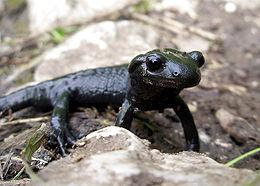Scientific classification:
Kingdom: Animalia
Phylum: Chordata
Class: Amphibia
Order: Caudata
Family: Salamandridae
Genus: Salamandra
Species: S. atra
The Alpine Salamander (Salamandra atra) is a shiny black salamander. It is found in the Central, Eastern and Dinaric Alps, at altitudes above 700 meters. The Western Alps are inhabited by a similar species Salamandra lanzai in only one small area. There are no differences in length between sexes (9 to 14 cm) and sex ratio is 1:1. Their life expectancy is at least ten years. Unlike other salamanders where larvae are developed in water Alpine salamander is a fully terrestrial species. Capture-recapture methods suggest that species is very stationary, a 12 meters was the maximal observed distance travelled by one individual during summer season. 120 individuals per hectare were counted in most suitable areas with >2000 individuals/ha also observed. This suggests that this rather criptic species is quite abundant.
Subspecies
- Salamandra atra atra, fully melanistic (black) subspecies from Central, Eastern and Dinaric Alps
- S. a. aurorae, the Golden Alpine Salamander is classified as being Critically Endangered on the IUCN Red List 2002. This subspecies has golden or yellow spots on its back and lives in a small area in Venetian Prealps near Asiago.
- S. a. pasubiensis, with less yellow spots than aurorae lives in a different part of Venetian Prealps (Pasubio massif).
- S. a. prenjensis lives on Prenj mountain, part of Dinaric Alps in Bosnia and Herzegovina. Validity of this subspecies is yet to be confirmed.
Genetic analyzes suggest that Salamandra corsica is the closest related species and that black-yellow coloration is an ancestral feature of Alpine salamanders. Proposed colonization from south (Prealps) to Alps was carried out by fully melanistic (derived feature) S. a. atra after the last retreat of the ice sheets.[3]
Reproduction
Mating occurs on land, the male clasping the female at the arms, and the impregnation is internal. S. atra is an ovoviviparous amphibian, giving birth to two live young, or rarely three or four. They may measure as much as 50 mm. at birth, the mother measuring only 120. The uterine eggs are large and numerous, but as a rule only one fully develops in each uterus, the embryo being nourished on the yolk of the other eggs, which more or less dissolve to form a large mass of nutrient matter. The embryo passes through three stages:[4]
- still enclosed within the egg and living on its own yolk
- free, within the vitelline mass, which is directly swallowed by the mouth
- there is no more vitelline mass, but the embryo is possessed of long external gills, which serve for an exchange of nutritive fluid through the maternal uterus, these gills functioning in the same way as the chorionic villi of the mammalian egg.
Generally, at altitudes of 650-1,000 metres, a pregnancy lasts 2 years, and at altitudes of 1,400 to 1,700 metres, the pregnancy lasts 3 years
Alfred Edmund Brehm: Az állatok világa - Légrády testvérek (1905)
A Tudás Fája/ Állatok/ Szalamandrák és gőték
http://hu.wikipedia.org/wiki/Alpesi_szalamandra
http://biomasssza.uw.hu/salatr.html
